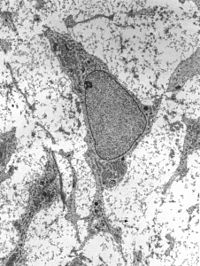
Photo from wikipedia
Premature ovarian insufficiency (POI) is clinically irreversible in women aged over 40 years. Although numerous studies have demonstrated satisfactory outcomes of mesenchymal stem cell therapy, the underlying therapeutic mechanism remains unclear.… Click to show full abstract
Premature ovarian insufficiency (POI) is clinically irreversible in women aged over 40 years. Although numerous studies have demonstrated satisfactory outcomes of mesenchymal stem cell therapy, the underlying therapeutic mechanism remains unclear. Exosomes were collected from the culture medium of human umbilical cord mesenchymal stem cells (hUMSCs) and assessed by electron microscopy and Western blot (WB) analysis. Then, exosomes were added to the culture medium of cyclophosphamide (CTX)‐damaged human granulosa cells (hGCs), and the mixture was injected into the ovaries of CTX‐induced POI model mice before detection of antiapoptotic and apoptotic gene expression. Next, the microRNA expression profiles of hUMSC‐derived exosomes (hUMSC‐Exos) were detected by small RNA sequencing. The ameliorative effect of exosomal microRNA‐17‐5P (miR‐17‐5P) was demonstrated by miR‐17‐5P knockdown before assessment of ovarian phenotype and function, reactive oxygen species (ROS) levels and SIRT7 expression. Finally, SIRT7 was inhibited or overexpressed by RNA interference or retrovirus transduction, and the protein expression of PARP1, γH2AX, and XRCC6 was analyzed. The ameliorative effect of hUMSC‐Exos on POI was validated. Our results illustrated that hUMSC‐Exos restored ovarian phenotype and function in a POI mouse model, promoted proliferation of CTX‐damaged hGCs and ovarian cells, and alleviated ROS accumulation by delivering exosomal miR‐17‐5P and inhibiting SIRT7 expression. Moreover, our findings elucidated that miR‐17‐5P repressed PARP1, γH2AX, and XRCC6 by inhibiting SIRT7. Our findings suggest a critical role for exosomal miR‐17‐5P and its downstream target mRNA SIRT7 in hUMSC transplantation therapy. This study indicates the promise of exosome‐based therapy for POI treatment.
Journal Title: STEM CELLS
Year Published: 2020
Link to full text (if available)
Share on Social Media: Sign Up to like & get
recommendations!